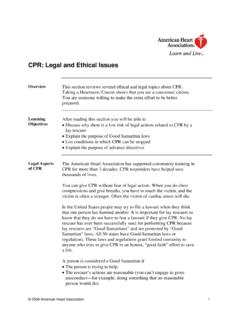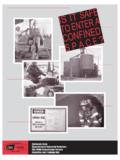Transcription of HEALTH 0 HEALTH INSTABILITY OTHER MATERIAL SAFETY …
1 NITROGEN GAS LIQUID NITROGEN. NFPA RATING. NFPA RATING FLAMMABILITY. FLAMMABILITY. 0. 0. HEALTH 3 0 INSTABILITY . HEALTH 0 0 INSTABILITY . OTHER OTHER . MATERIAL SAFETY DATA SHEET. Prepared to OSHA, CMA, ANSI and Canadian WHMIS Standards PART I What is the MATERIAL and what do I need to know in an emergency? 1. PRODUCT IDENTIFICATION. CHEMICAL NAME; CLASS: NITROGEN - N2. LIQUEFIED NITROGEN N2, (Cryogenic). Document Number: 001040. PRODUCT USE: For General Analytical/Synthetic Chemical Uses SUPPLIER/MANUFACTURER'S NAME: AIRGAS INC. ADDRESS: 259 North Radnor-Chester Road Suite 100. Radnor, PA 19087-5283. BUSINESS PHONE: 1-610-687-5253. EMERGENCY PHONE: 1-800-949-7937. International: 423-479-0293. DATE OF PREPARATION: May 12, 1996. REVISION DATE : December 8, 2003. 2. COMPOSITION and INFORMATION ON INGREDIENTS. CHEMICAL NAME CAS # mole % EXPOSURE LIMITS IN AIR. ACGIH-TLV OSHA-PEL NIOSH OTHER .
2 TWA STEL TWA STEL IDLH. ppm ppm ppm ppm ppm ppm Nitrogen 7727-37-9 >99 % There are no specific exposure limits for Nitrogen. Nitrogen is a simple asphyxiant (SA). Oxygen levels should be maintained above Maximum Impurities <1% None of the trace impurities in this mixture contribute significantly to the hazards associated with the product. All hazard information pertinent to this product has been provided in this MATERIAL SAFETY Data Sheet, per the requirements of the OSHA Hazard Communication Standard (29 CFR ) and State equivalents standards. NE = Not Established. See Section 16 for Definitions of Terms Used. NOTE (1): ALL WHMIS required information is included in appropriate sections based on the ANSI format. This gas has been classified in accordance with the hazard criteria of the CPR and the MSDS contains all the information required by the CPR. NITROGEN - N2 MSDS (Document # 001040) PAGE 1 OF 10.
3 3. HAZARD IDENTIFICATION. EMERGENCY OVERVIEW: Nitrogen is a colorless, odorless, non-flammable gas, or a colorless, odorless, cryogenic liquid. The main HEALTH hazard associated with releases of this gas is asphyxiation, by displacement of oxygen. The cryogenic liquid will rapidly boil to the gas at standard temperatures and pressures. The liquefied gas can cause frostbite to any contaminated tissue. NITROGEN GAS LIQUID NITROGEN. HAZARDOUS MATERIAL IDENTIFICATION SYSTEM HAZARDOUS MATERIAL IDENTIFICATION SYSTEM. HEALTH HAZARD (BLUE) 0 HEALTH HAZARD (BLUE) 3. FLAMMABILITY HAZARD (RED) 0 FLAMMABILITY HAZARD (RED) 0. PHYSICAL HAZARD (YELLOW) 0 PHYSICAL HAZARD (YELLOW) 0. PROTECTIVE EQUIPMENT PROTECTIVE EQUIPMENT. EYES RESPIRATORY HANDS BODY EYES RESPIRATORY HANDS BODY. See See See See Section 8 Section 8 Section 8 Section 8. For Routine Industrial Use and Handling Applications For Routine Industrial Use and Handling Applications See Section 16 for Definition of Ratings SYMPTOMS OF OVEREXPOSURE BY ROUTE OF EXPOSURE: The most significant route of overexposure for this gas is by inhalation.
4 The following paragraphs describe symptoms of exposure by route of exposure. INHALATION: High concentrations of this gas can cause an oxygen-deficient environment. Individuals breathing such an atmosphere may experience symptoms which include headaches, ringing in ears, dizziness, drowsiness, unconsciousness, nausea, vomiting, and depression of all the senses. The skin of a victim may have a blue color. Under some circumstances, death may occur. The effects associated with various levels of oxygen are as follows: CONCENTRATION SYMPTOMS OF EXPOSURE. 12-16% Oxygen: Breathing and pulse rate increased, muscular coordination slightly disturbed. 10-14% Oxygen: Emotional upset, abnormal fatigue, disturbed respiration. 6-10% Oxygen: Nausea and vomiting, collapse or loss of consciousness. Below 6%: Convulsive movements, possible respiratory collapse, and death. OTHER POTENTIAL HEALTH EFFECTS: Contact with cryogenic liquid or rapidly expanding gases (which are released under high pressure) may cause frostbite.
5 Symptoms of frostbite include change in skin color to white or grayish-yellow. The pain after contact with liquid can quickly subside. HEALTH EFFECTS OR RISKS FROM EXPOSURE: An Explanation in Lay Terms. Overexposure to Nitrogen may cause the following HEALTH effects: ACUTE: The most significant hazard associated with this gas is inhalation of oxygen-deficient atmospheres. Symptoms of oxygen deficiency include respiratory difficulty, headache, dizziness and nausea. At high concentrations, unconsciousness or death may occur. Contact with cryogenic liquid or rapidly expanding gases may cause frostbite. CHRONIC: Chronic exposure to oxygen-deficient atmospheres (below 18% oxygen in air) may affect the heart and nervous system. TARGET ORGANS: ACUTE: Respiratory system. CHRONIC: Cardiac system, central nervous system. NITROGEN - N2 MSDS (Document # 001040) PAGE 2 OF 10.. PART II What should I do if a hazardous situation occurs?
6 4. FIRST-AID MEASURES. rescuers should NOT ATTEMPT TO RETRIEVE VICTIMS OF EXPOSURE TO NITROGEN WITHOUT. ADEQUATE PERSONAL PROTECTIVE EQUIPMENT. At a minimum, Self-Contained Breathing Apparatus and protective clothing should be worn. Remove victim(s) to fresh air, as quickly as possible. Trained personnel should administer supplemental oxygen and/or cardio-pulmonary resuscitation, if necessary. Only trained personnel should administer supplemental oxygen. Victim(s) must be taken for medical attention. rescuers should be taken for medical attention, if necessary. Take copy of label and MSDS to physician or OTHER HEALTH professional with victim(s). In case of frostbite, place the frostbitten part in warm water. DO NOT USE HOT WATER. If warm water is not available, or is impractical to use, wrap the affected parts gently in blankets. Alternatively, if the fingers or hands are frostbitten, place the affected area of the body in the armpit.
7 Encourage victim to gently exercise the affected part while being warmed. Seek immediate medical attention. MEDICAL CONDITIONS AGGRAVATED BY EXPOSURE: Pre-existing respiratory conditions may be aggravated by overexposure to Nitrogen. RECOMMENDATIONS TO PHYSICIANS: Administer oxygen, if necessary. Treat symptoms and reduce overexposure. 5. FIRE-FIGHTING MEASURES. NITROGEN GAS LIQUID NITROGEN. NFPA RATING NFPA RATING. FLAMMABILITY FLAMMABILITY. 0 0. HEALTH 0 0 INSTABILITY HEALTH 3 0 INSTABILITY . OTHER OTHER . See Section 16 for Definition of Ratings FLASH POINT: Not applicable. AUTOIGNITION TEMPERATURE: Not applicable. FLAMMABLE LIMITS (in air by volume, %): Lower (LEL): Not applicable. Upper (UEL): Not applicable. FIRE EXTINGUISHING MATERIALS: Non-flammable, inert gas. Use extinguishing media appropriate for surrounding fire. UNUSUAL FIRE AND EXPLOSION HAZARDS: Nitrogen does not burn; however, containers, when involved in fire, may rupture or burst in the heat of the fire.
8 RESPONSE TO FIRE INVOLVING CRYOGEN: Cryogenic liquids can be particularly dangerous during fires because of their potential to rapidly freeze water. Careless use of water may cause heavy icing. Furthermore, the relatively warm water greatly increases the evaporation rate of Nitrogen. If large concentrations of Nitrogen gas are present, the water vapor in the surrounding air will condense, creating a dense fog that may make it difficult to find fire exits or equipment. Liquid Nitrogen, when exposed to the atmosphere, will produce a cloud of ice/fog in the air upon its release. Explosion Sensitivity to Mechanical Impact: Not Sensitive. Explosion Sensitivity to Static Discharge: Not Sensitive. SPECIAL FIRE-FIGHTING PROCEDURES: Structural fire-fighters must wear Self-Contained Breathing Apparatus and full protective equipment. Move fire-exposed cylinders if it can be done without risk to firefighters.
9 Otherwise, cool containers with hose stream and protect personnel. Withdraw immediately in case of rising sounds from venting SAFETY device or any discoloration of tanks due to the fire. NITROGEN - N2 MSDS (Document # 001040) PAGE 3 OF 10. 6. ACCIDENTAL RELEASE MEASURES. SPILL AND LEAK RESPONSE: Uncontrolled releases should be responded to by trained personnel using pre- planned procedures. Proper protective equipment should be used. In case of a release, clear the affected area and protect people. Minimum Personal Protective Equipment should be Level B: protective clothing, mechanically- resistant gloves and Self-Contained Breathing Apparatus. Locate and seal the source of the leaking gas. Allow the gas to dissipate. Monitor the surrounding area for oxygen levels. The atmosphere must have at least percent oxygen before personnel can be allowed in the area without Self-Contained Breathing Apparatus.
10 Attempt to close the main source valve prior to entering the area. If this does not stop the release (or if it is not possible to reach the valve), allow the gas to release in-place or remove it to a safe area and allow the gas to be released there. RESPONSE TO CRYOGENIC RELEASE: Clear the affected area and allow the liquid to evaporate and the gas to dissipate. After the gas is formed, follow the instructions provided in the previous paragraph. If the area must be entered by emergency personnel, SCBA, Kevlar gloves, and appropriate foot and leg protection must be worn. PART III How can I prevent hazardous situations from occurring? 7. HANDLING and STORAGE. WORK PRACTICES AND HYGIENE PRACTICES: As with all chemicals, avoid getting Nitrogen IN YOU. Do not eat or drink while handling chemicals. Be aware of any signs of dizziness or fatigue; exposures to fatal concentrations of Nitrogen could occur without any significant warning symptoms, due to oxygen deficiency.





